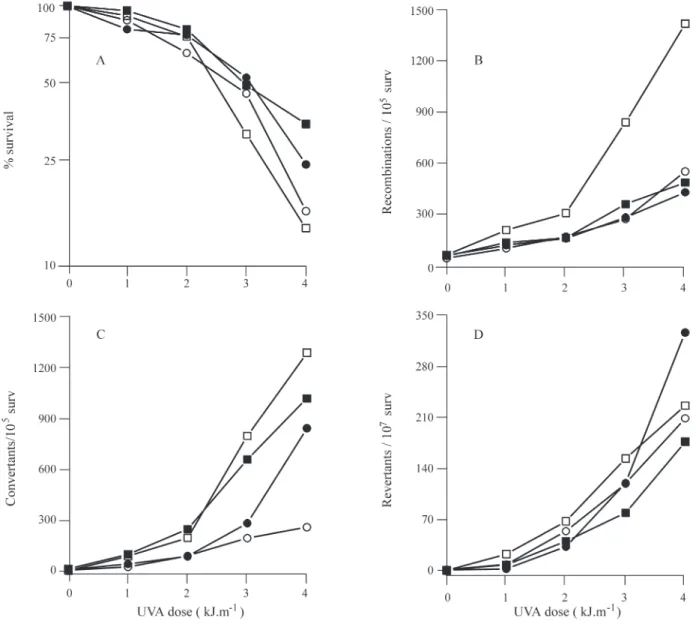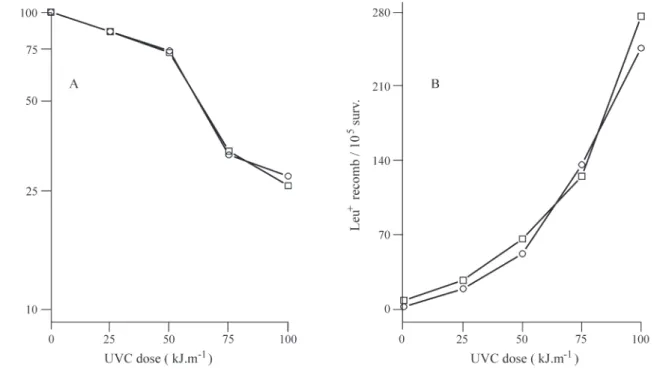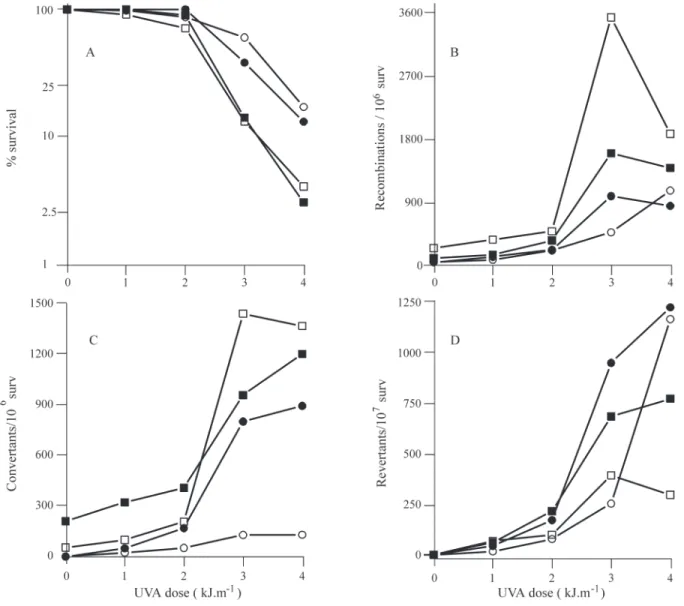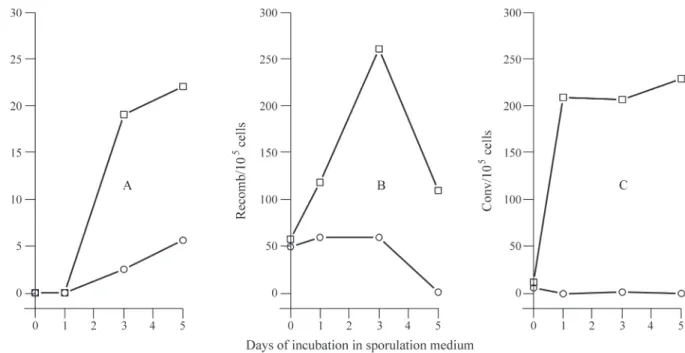Expression of the bacterial
recA
gene impairs genetic recombination and
sporulation in a
Saccharomyces cerevisiae
diploid strain
Marcos Antonio de Morais Junior
1, José Ferreira dos Santos
1and João Antonio Pegas Henriques
21
Departamento de Genética, Universidade Federal de Pernambuco, Recife, PE, Brazil.
2Departamento de Biofísica, Universidade Federal do Rio Grande do Sul, Porto Alegre, RS, Brazil.
Abstract
TheEscherichia coli RecA protein (RecAp) has been demonstrated to induce mutagenesis in yeast cells, although there is still little information on the role of the RecAp in yeast recombination events. We evaluated spontaneous and induced general recombination in vegetative and meiotic cells of the XS2316 strain of the yeastSaccharomyces cerevisiae bearing the recA gene. We found that RecAp decreased reciprocal recombination, gene conversion and intrachromosomal recombination and promoted an increase in error-prone processes in both vegetative and meiotic cells, while its negative effect on meiotic recombination blocked ascospore formation.
Keywords:DNA repair, genetic recombination,recAgene, sporulation, yeast. Received: November 22, 2002; accepted: March 10, 2003.
Introduction
The bacterialrecA protein (RecAp) is primarily in-volved in the repair of DNA damaged during recombina-tion events but also funcrecombina-tions in general recombinarecombina-tion processes (Kowalczykowskiet al., 1994), these roles hav-ing been conserved durhav-ing evolution and transferred to sev-eral proteins in eukaryotic cells. In the yeast
Saccharomyces cerevisiaetheRAD51,RAD55,RAD57 and
DMC1 genes are considered as recA gene homologues (Kanz and Mortimer, 1991; Bishopet al., 1992; Shinohara
et al., 1992; Lovett, 1994), the Rad51 protein (Rad51p) having been demonstrated to form a RecAp-like nucleo-protein structure responsible for ATP-dependent homolo-gous DNA pairing and strand exchange (Sung and Roberson, 1995).
When expressed in S. cerevisiae, RecAp has been shown to increase the resistance of wild-type cells to the killing effect of ionizing radiation (Brozmanová et al., 1991), to partially restore induced reverse mutation inpso4 mutant (de Morais Jret al., 1994) and to partially comple-ment the sensitivity of rad52 mutant to DNA damaging agents (de Morais Jret al., 1998). Although being very sim-ilar to Rad51p, RecAp failed to complement the sensitive phenotype of rad51 mutant (de Morais Jr et al., 1998), probably due to lack of a structural domain in the RecAp
N-terminal region or because of the different polarity of DNA strand transfer reactions mediated by RecAp and Rad51p (Milne and Weaver, 1993; Sung and Robberson, 1995). It appears that although RecAp is active in promot-ing DNA repair events in yeasts its effects seems to be closely dependent on the genetic background of the yeast strain, e.g. despite the fact that RecAp restored induced mu-tation inpso4mutant (de Morais Jret al., 1994) it drasti-cally decreased the hypermutagenic effect of the rad52
mutant (de Morais Jret al., 1998) and was unable to restore recombination repair inpso4-1 mutant (Slaninova et al., 1997; Vlckova et al., 1997). Analysis of single point missense mutations revealed that RecAp has functional do-mains that are responsible for its biological functions in the induction of SOS, recombination and error-prone repair (Sweasyet al., 1990).
We previously demonstrated that error-prone RecAp repair is active in yeast cells (de Morais Jret al., 1994) but the involvement of RecAp in recombination was not clear and because of this we decided to investigate the effect of the expression of therecAgene on the general type of re-combination which normally occurs in wild type haploid and diploid yeast cells. The results presented in this paper suggest that RecAp interacts with protein in the yeast recombinosome complex and that it acts as a dominant neg-ative allele due to its high but opposite biological activity in regard to strand pairing and branch migration as compared to functionally homologous yeast proteins.
Send correspondence to Marcos Antonio de Morais Junior. Depar-tamento de Genética, Universidade Federal de Pernambuco, Av. Moraes Rego, s/n. Cidade Universitária, 50732-970 Recife, PE, Brazil. E-mail: morais@lika.ufpe.br.
Strains and plasmids
The genotype of the diploid Saccharomyces cerevisiae strain XS2316 (de Morais Jr et al., 1994) is
MATa/α +/ade6 leu1-12/leu1-12 Trp5-48/+ +/cyh2
+/met13 +/lys5-1 his1-1/ his1-1 and that of the haploid strain MB401-3c (Meiraet al., 1992)MATa lys2ura3-52 (his4-39/260: pBR322: his4-1176/864), strain MB401-3c having duplicatehis4 mutations cloned at orientation II into theHIS4locusof chromosome III that can be reverted for His4 prototrophy after pop-out recombination.Escherichia colistrain DH5α (Stratagene, CA) was used for plasmid
amplification, a pNF2recAplasmid being constructed us-ing the pNF2 plasmid (which was also used as a control) as described by de Morais Jret al.(1994). Yeast cells were transformed using the lithium chloride procedure of Itoet al.(1983). Transformed cells were incubated overnight in yeast-extract peptone dextrose (YEPD) broth ((%, w/v) yeast extract, 1; peptone, 2; dextrose, 2), before being se-lected using selective YEPD plates (YEPD broth contain-ing 2% (w/v) agar and 600 µg/mL of the antibiotic
Geneticin) for 4 days incubation at 28 °C. The immunoblot method using polyclonal anti-RecA antibody was used to detectrecAgene expression (de Morais Jret al., 1998).
Media for growth and selection of Yeasts
For mitotic growth we used YEPD broth,
pre-sporulation (PS) medium (containing (%, w/v) yeast extract, 0.250; potassium acetate, 0.1; dextrose 1) being used to synchronize diploid cells and sporulation (SPA) medium (containing 2% (w/v) potassium acetate supple-mented with amino acids and bases) to induce sporulation. Selective yeast extract nitrogen base (YNB) medium (con-taining (%, w/v) YNB, 0.67; dextrose, 2; ammonium sul-fate, 0.5; agar, 2; supplemented with appropriate acids and bases) was used to detect reverse mutation and pop-out re-combination (selective YNB lacking histidine) and gene conversion (selective YNB lacking leucine) and YEPD supplemented with 200µg/mL of cycloheximide for
recip-rocal recombination analysis. All media having been de-scribed in de Morais Jret al. (1998) and da Silvaet al.
(1995).
Growth conditions
Both transformed and untransformed XS2316 or MB401-3c strains were cultivated overnight in YEPD broth at 28 °C with agitation (200 rev.min-1) until they reached the stationary phase (~2 x 108cells.mL-1). For ex-periments using exponential phase cells, cultures were di-luted 1:100 in fresh YEPD and allowed to grow for additional four hours. In both cases, the cells were washed twice and resuspended in 0,9% (w/v) NaCl to 1-2 x 107 cells.mL-1and exposed to mutagens as described below.
1995), overnight YEPD broth cultures of strain XS2316, prepared as described above, were diluted with PS medium to 8 x 106cells.mL-1and incubated for further 21 h at 28 °C, after which the cells were harvested by centrifugation, washed, re-suspended in SPA medium and re-incubated at the same temperature for up to 7 days. Samples were taken after 1, 3, 5 and 7 days incubation, in each case the cells were scored for spore formation using phase-contrast mi-croscopy, washed twice in 0.9% (w/v) NaCl, resuspended to 1-2 x 107cells.mL-1and submitted to mutagen treatment as described below.
Mutagenesis
Cell suspensions were incubated in Petri dishes at 4 °C for 15 min in the presence of 50 mM of 8-Methoxypsoralen (8-MOP, Sigma, USA), after which were irradiated with 365 nm ultra violet A (UVA) using a 9/7 W Osram lamp at an intensity of 1 kJ.m-2.min-1. Treat-ment with 254 nm ultra violet C (UVC) used a 15 W Phil-lips TUV germicidal lamp at an intensity of 37.5 Jm-2.min-1. For both treatments the doses were as indicated in the fig-ures. After appropriated dilution, cell suspensions were plated onto non-selective YEPD agar for cell survival or 100 to 300µL was directly plated onto YNB medium to
de-tect reverse mutation, reciprocal recombination and gene conversion (de Morais Jr.et al., 1998).
Ascospore formation
Yeast cells were synchronized for sporulation before incubation in SPA medium. At specific periods during in-cubation cells were collected and plated onto selective YNB medium to asses reciprocal recombination and gene conversion. Cells were also evaluated for ascospore forma-tion using optical microscopy and stained with 0.5% (w/v) malachite green and 0.5% (w/v) safranin to differentiate mitotic (red) from meiotic (green) cells (Streiblová, 1988).
Results
Yeast transformation and recA gene expression
Haploid and diploid yeast cells were transformed with the pNF2 and pNF2recA plasmids and the transformants selected using geneticin-supplemented YEPD agar, low transformation efficiency being found for both plasmids with no significant difference in frequency between the two plasmids. Immunoblot analysis showed that the 38 KDa RecAp was efficiently produced by both haploid and diploid transformed yeast cells, with cellular growth rate appearing to be unaffected by expression of the
recAgene (see de Morais Jret al., 1998).
Mitotic DNA repair in recA-expressing cells
cells being found to be more resistant to killing by 8-MOP+UVA than stationary phase cells (Figure 1) with
recA expression not affecting the survival of plasmid-bearing cells (Figure 1a). There was more 8-MOP+UVA induced reciprocal recombination in non-dividing station-ary phase cells than in exponential phase cells, the presence of RecAp resulting in a 3 to 4-fold reduction of reciprocal recombination in the stationary phase cells to the level oc-curring in exponential phase cells, which were unaffected by the presence of RecAp (Figure 1b). Gene conversion fre-quency showed the same induction pattern irrespective of growth phase, while the presence of RecAp reduced gene conversion frequency for both stationary and exponential phase cells, stationary phase cells showing the greater re-duction (Figure 1c). In cells expressing therecAgene there was a slight increase in 8-MOP induced reverse mutation in
exponential phase cells compared to stationary phase cells (Figure 1d).
We also investigated the killing effects of UVC on exponential and stationary phase diploid transformed cells, and found that expression of therecAgene did not change either cell survival or gene conversion rates (Figure 2 showing typical results for exponential phase cells) nor were reciprocal recombination or reverse mutation rates al-tered by the presence of RecAp.
Haploid yeast cells of strain MB401-3c harboring di-rect-repeat his4 alleles on chromosome III were used to evaluate intrachromosomal pop-out recombination, and we found that, similar to the case with diploid cells, the pres-ence of therecAgene did not affected the survival of sta-tionary phase cells treated with 8-MOP+UVA (Figure 3). In stationary phase haploid MB401-3c cells harboring the
Figure 1- Effect ofrecAgene expression on mitotic diploid yeast cells treated with 8-MOP+UVA. Figure A, percentage cell survival; Figure B, recipro-cal recombination; Figure C, gene conversion; Figure D, reverse mutation. Yeast transformants harboring the control pNF2 plasmid (±) or pNF2recA
recAgene, pop-out recombination induced by 8-MOP de-creased after doses of 2 kJ.m-1UVA. The cell survival and pop-out recombination rates of exponential phase cells were not affected by the presence of RecAp.
Analysis of the biological parameters tested at spon-taneous level revealed that reciprocal recombination, gene conversion and pop-out recombination were significantly
decreased by a factor of 2 inrecA-expressing cells, while reverse mutation showed a 2-fold increase (Table 1).
Meiotic DNA repair and sporulation
Using the return-to-growth method we examined the effects of recA gene expression on recombination, gene conversion and reverse mutation of the sporulating cells of Figure 2- Effect of UVC (254 nm) treatment on the percentage cell survival (Figure A) and gene conversion rate (Figure B) of stationary phase mitotic diploid yeast cells harboring therecAgene, symbols as in Figure 1.
strain XS2316 after 8-MOP photoaddition (Figure 4). The cells were collected and treated with mutagens after one or three days of incubation in SPA medium, these periods ing chosen because it was known that cell metabolism be-came directed towards sporulation within 24 h of incubation and that the highest rate of spore formation oc-curs after three days incubation (da Silva et al., 1995). Yeast cells were more sensitive to the killing effect of 8-MOP+UVA during the metabolic change to meiosis than
were mitotic cells, albeit they did not differ as they were at the beginning of sporulation or already sporulated (Figure 4a). When cells were incubated for one or three days in SPA medium there was a significant increase in survival to 8-MOP+UVA by cells expressing therecA gene (Figure 4a). We found a slight reduction in 8-MOP+UVA induced reciprocal recombination and gene conversion in recA
transformed cells incubated in SPA medium, this effect be-ing more pronounced after three days incubation when Table 1- Spontaneous frequences of reciprocal recombination (RC), gene conversion (GC), intrachromosomal pop-out recombination (IR) and reverse mutation (RM) in yeast mitotic cells expressing (pNF2recA) or not (pNF2) therecAgene.
Strain RC
Recombinants/105cells
GC
Recombinantes/105cells
IR
Recombinantes/106cells
RM Mutants/107cells
pNF2 608 ± 89 14.3 ± 4.9 115 ± 36 0.76 ± 0.66
PNF2recA 414 ± 71 6.2 ± 3.5 53 ± 19 1.74 ± 0.54
Figure 4- Effect ofrecAgene expression on meiotic diploid yeast cells treated with 8-MOP+UVA. Figure A, percentage cell survival; Figure B, recipro-cal recombination; Figure C, gene conversion; Figure D, reverse mutation. Yeast transformants harboring control pNF2 plasmid (±) or pNF2recA
duced gene conversion (Figures 4b and 4c), inhibition again being more pronounced at UVA doses above 2 kJ.m-2. Analysis of induced mutagenesis showed that one-day old cells were more error-prone than three-day old cells. Despite the fact that general recombination was re-duced the inre-duced reverse mutation rate was increased by the presence of therecAgene in cells incubated for one and three days, mainly for those cells exposed to the highest UVA dose of 4 kJ.m-2(Figure 4d). These results for cells undergoing meiosis are consistent with the spontaneous or induced response of mitotic cells (Table 1).
The above results demonstrated to us that recombina-tion repair in both mitotic and meiotic yeast cells was im-paired by the presence of RecAp and because of this we decided to investigate the influence of RecAp on the basic recombination mechanism responsible for chromosomal rearrangement and spore formation. We evaluated ascospore formation and genetic recombination during in-cubation in SPA medium and found that strain XS2316 lacking therecAgene (the control) started to produce asci after 24 h of incubation with 23% of cells exhibiting asci af-ter five days incubation, while the presence of RecAp pro-moted a five-fold reduction in ascospore formation with only 5% of cells containing asci after five days incubation (Figure 5a). Microscopy using differential staining showed that all mitotic vegetative cells expressingrecAwere red only (stained with safranin) while meiotic reproductive vector-bearing cells showed some red and some green structures (stained with malachite green and safranin). The
recA-expressing cells also showed defective sporulation
related to defective sporulation due to impaired meiotic re-combination. ForrecA-expressing yeast cells no meiotic in-duction of reciprocal recombination was observed (Figure 5b) and gene conversion was practically abolished (Figure 5c), showing that in these cells the defect in spore formation is due to the negative effect of RecAp on genetic recombi-nation.
Discussion
In mitotic cells, homologous genetic recombination is the mechanism responsible for repairing double-strand breaks (DSB) induced by DNA cross-linking agents (e.g.
8-MOP and ionizing and UV radiation) and mono-func-tional alkylating agents such as Methyl-nitro-nitroso-guanidine (MNNG) and Methyl-methano-sulphonate (MMS) (reviewed by Henriques and Brendel, 1990). Hays
et al.(1995) demonstrated that DSB repair in yeasts is cata-lyzed by the recombinosome complex which is thought to be formed by the interaction between the Rad51p and Rad52p proteins (Sung and Robberson, 1995), although DSB repair may also involve the RecAp homologous Rad55p (Lovett, 1994) and Rad57p (Kanz and Mortimer, 1991) proteins. Another RecAp homologous protein, Dmc1p, is specifically required for meiotic strand transfer and formation of the synaptonemal complex (Bishopet al., 1992), other proteins that may be involved in DSB repair being reviewed by Peteset al.(1991).
Our results demonstrate that RecAp is able to change the frequency of general spontaneous and induced mitotic recombination in yeast cells, with gene conversion
ing to be most negatively affected by the presence of Re-cAp. We found that 8-MOP+UVA induced reciprocal recombination and gene conversion were decreased (Figure 1) in XS2316 cells expressing the RecAp protein, which supports the findings of Vlckovaet al.(1997) who reported that although MNNG produced no effect on reciprocal re-combination, after treatment with 8-MOP+UVA induced reciprocal recombination and gene conversion were de-creased. On the other hand, our UVC-induced gene conver-sion results seem to be in contrast to some other reports because we found no effect on stationary phased XS2316 cells containing RecAp (Figure 2), while Vlckovaet al.
(1994, 1997) found that UVC-induced gene conversion in exponential phase diploid D7 and XS2361 cells was in-creased by the presence of RecAp. Since all the experi-ments discussed above were carried out using the same plasmid, differences in the results could be due to genetic background or growth phase. The results in Figure 3 show that intrachromosomal recombination of direct repeated
his4 mutant alleles induced by 8-MOP+UVA was de-creased by the presence of RecAp. Gene conversion in-duced by DSB has been considered to be the more frequent event during recombination of duplicated elements (Rayet al., 1988), which reinforces the hypothesis that RecAp can preferentially inhibit gene conversion in yeast cells.
Interestingly, the results of our meiotic genetic re-combination experiments showed that the frequency of both meiotic 8-MOP+UVA induced reciprocal recombina-tion and gene conversion was decreased by the presence of RecAp, this effect being more pronounced in cells cultured for three days where practically no induction was observed and induced gene conversion was once again completely abolished (Figure 4). However, the frequency of spontane-ous reciprocal recombination and gene conversion reached a maximum (Figure 5). Genetic recombination is generated by strand exchange between homologous strands of DNA that are physically connected by the synaptonemal com-plex, this mechanism ensuring proper segregation of chro-mosomes at meiosis I. Strand exchange is favored by the formation of double-strand breaks in both of the homolo-gous DNA strands which are repaired by a group of genes (mainly those involved in the RAD52 pathway) also in-volved in recombination repair, recombination being indis-pensable for sporulation. Figure 5 shows that reciprocal recombination and gene conversion start spontaneously on the first day of incubation in SPA (before the appearance of asci) which shows that the cells were committed to sporulation, although the presence of RecAp inhibited gen-eral recombination and blocked ascospore formation.
Our results point to the interaction between RecAp and yeast proteins during spontaneous or induced recombi-nation events, this hypothesis being supported by two lines of evidence. Firstly, in vitro experiments have demon-strated interaction between RecAp and the yeast sin-gle-strand binding protein y-RPA (Alaniet al., 1992) and,
secondly, it has been reported (de Morais Jret al., 1998) that the presence of RecAp increased the survival rate of
rad52 mutant cells exposed to 8-MOP+UVA and to MMS but not those exposed to UVC. This response is dependent on the presence of functional Rad51p as illustrated by the fact that no effect was observed in the double mutant
rad51rad52 (de Morais Jret al., 1998) which suggests that when Rad52p is absent RecAp can bind to its homologue Rad51p, RecAp producing a nucleoprotein complex con-taining DNA (mainly single-stranded) responsible for DNA pairing and strand exchange of homologous DNA molecules. InEscherichia coli,these events are dependent on DNA-binding and catalytic proteins which are part of the recombination complex (Kowalczykowskiet al.,1994), a similar nucleoprotein structure having been demonstrated for yeast Rad51p (Sung, 1994). The 55 N-terminal amino acid residues present in Rad51p show ATP-dependent ho-mologous pairing and strand exchange activities also im-portant for the interaction of Rad51p with Rad52p (Sung and Robberson, 1995), but since RecAp lacks these amino acids it could not complement defectiverad51 mutants (de Morais Jret al., 1998) but may interact with intact Rad51p through their homologous C-terminal regions to form a heteropolymeric spiral filament. RecAp was shown to pro-mote Holliday junction and branch migration between in-tact single-strand DNA and homologous damaged double-strand DNA, leading to the formation of intermedi-ate heteroduplex DNA which is processed to produce a gene conversion event (Kowalczykowski et al., 1994). However, DNA strand transfer reactions mediated by either
RecAp or Rad51p have been demonstrated to have different polarities (Sung and Robberson, 1995) because of which the putative chimeric structure formed by rad51p-RecAp in the yeast nucleus might interfere in the biochemical activity of the spiral filament by arresting branch migration and in-hibiting correct DNA strand transfer. RecAp should act as a dominant negative allele in this process, experiments using deleted forms of theRAD52 gene having demonstrated that Rad52p with deleted recombination activity but normal Rad51p binding competed with wild-type Rad52p for the Rad51-Rad52 protein complex and acted as a dominant negative allele inhibiting double-strand break repair (Milne and Weaver, 1993).
The evidence suggests that RecAp actively partici-pates in yeast DNA repair by interacting with yeast protein and binding directly to yeast chromosomes, although its bi-ological activity seems to be closely dependent on other key elements such as yeast proteins, type of DNA damage, the DNA repair pathway involved and the growth phase of the cell.
Acknowledgments
toxicidade (Genotox/Cbiot/UFRGS).
References
Alani E, Threscher R, Griffith JD and Kolodner RD (1992) Char-acterisation of DNA-binding and strand-exchange stimula-tion properties of y-RPA, a yeast single-strand DNA biding protein. J Mol Biol 227:54-71.
Bishop DK, Park D, Xu L and Kleckner N (1992)DMC1: a meio-sis-specific yeast homolog ofE. coli recArequired for re-combination, synaptonemal complex formation, and cell cycle progression. Cell 69:439-456.
Brozmanová J, Cernaková L, Vlcková V, Duraj J and Fridrishová I (1991) TheEscherichia coli recAgene increases resistance of the yeastSaccharomyces cerevisiaeto ionizing radiation and ultraviolet radiation. Mol Gen Genet 227:473-480. da Silva KVCL, Morais Jr MA and Henriques JAP (1995) The
PSO4 gene ofS. cerevisiaeis important for sporulation and the meiotic DNA repair of photoactivated psoralen lesions. Curr Genet 27:207-212.
de Morais Jr MA, Brozmanová J, Benfato MS, Duraj J, Vlcková V and Henriques JAP (1994) The E. colirecAgene can restore the defect in mutagenesis of the pso4-1 mutant of S. cerevisiae. Mutat Res 314:209-220.
de Morais Jr MA, Vlckova V, Fridrichova I, Slaninova M, Brozmanova J and Henriques JAP (1998) Effect of bacterial
recAexpression on DNA repair in therad51andrad52 mu-tants ofSaccharomyces cerevisiae.Genet Mol Biol 21:3-9. Hays SL, Firmenich AA and Berg P (1995) Complex Formation in Yeast Double-Strand Break Repair: Participation of Rad51, Rad52, Rad55, and Rad57 Proteins. Proc Natl Acad Sci (USA) 92:6925-6929.
Henriques JAP and Brendel M (1990) The role ofPSOandSNM
genes in DNA repair of the yeastSaccharomyces cerevisiae. Curr Genet 18:387-393.
Ito H, Fukuda Y, Murata K and Kimura A (1983) Transformation of intact yeast cells treated with alkali cations. J Bacteriol 153:163-168.
Kanz JA and Mortimer RK (1991) Nucleotide sequence of the
RAD57gene ofSaccharomyces cerevisiae. Gene 105:139-140.
Kowalczykowsky SC, Dixon DA, Eggleston AK, Lauder SD and Rehrauer WM (1994) Biochemistry of homologous recom-bination inEscherichia coli. Microbiol Rev 58:401-465. Lovett ST (1994) Sequence of the RAD55 gene of Saccharomyces
cerevisiae: similarity of Rad55 to procaryotic RecA and other RecA-like proteins. Gene 142:103-106.
Henriques JAP (1992) Thepso4-1mutation reduces sponta-neous mitotic gene conversion and reciprocal recombination inSaccharomyces cerevisiae.Mol Gen Genet 235:311-316. Milne G and Weaver D (1993) Dominant negative alleles of
RAD52 reveal a DNA repair/recombination complex in-cluding Rad51 and Rad52. Genes Develop 7:1755-1765. Petes TD, Malone RE and Symington LS (1991) Recombination
in yeast. In: Broach JW, Prigle JR and Jones EW (eds) The molecular and cellular biology of the yeast Saccharomyces cerevisiae: genome dynamics, proteins synthesis and energetics. Cold Spring Harbor Laboratory Press, Cold Spring Harbor, pp 407-512.
Ray A, Siddiqi I, Kolodkin AL and Sthal FW (1988) Intrachromosomal gene conversion induced by a DNA dou-ble-strand break inSaccharomyces cerevisiae. J Mol Biol 201:247-260.
Shinohara A, Ogawa H and Ogawa T (1992) Rad51 protein in-volved in repair and recombination in S. cerevisiae is a RecA-like protein. Cell 69:457-470.
Slaninova M, Vlckova V, Brozmanova J, Morais Jr MA and Henriques JAP (1997) Biological consequences ofE. coli
RecA protein expression in the repair defectivepso4-1and
rad::URA3 mutants of S. cerevisiae after treatment of N-methyl-N-nitro- nitrosoguanidine. Neoplasma 43:315-319.
Sung P (1994) Catalysis of ATP-dependent homologous DNA pairing and strand exchange by yeast Rad51 protein. Science 265:1241-1243.
Sung P and Robberson DL (1995) DNA strand exchange medi-ated by a RAD51-ssDNA nucleoprotein filament with polar-ity opposite to that of RecA. Cell 82:453-461.
Streiblová E (1988) Cytological methods. In: Campbell I and Duffs JH (eds) Yeast, a practical approach. IRL Press Ltd, Oxford, pp 9-50.
Sweasy JB, Witkin EM, Sinha N and Roegner-Maniscalco V (1990) RecA protein ofEscherichia colihas a third essential role in SOS mutator activity. J Bacteriol 172:3030-3036. Vlckova V, Cernaková L, Farkashová E and Brozmanová J (1994)
The Escherichia colirecAgene increases UV-induced mi-totic gene conversion in Saccharomyces cerevisiae. Curr Genet 25:472-474.
Vlckova V, Slaninova M, Morais Jr MA, Henriques, JAP and Brozmanova J (1997) Searching for the functional homology between yeast Pso4 and bacterial RecA proteins in induced mitotic recombination. Neoplasma 44:374-379.



